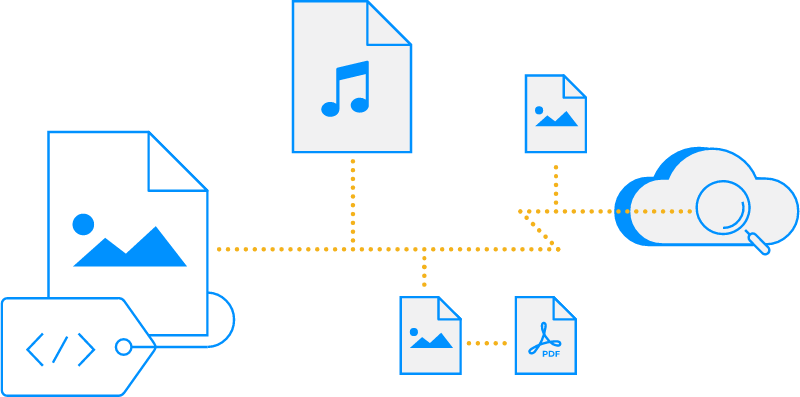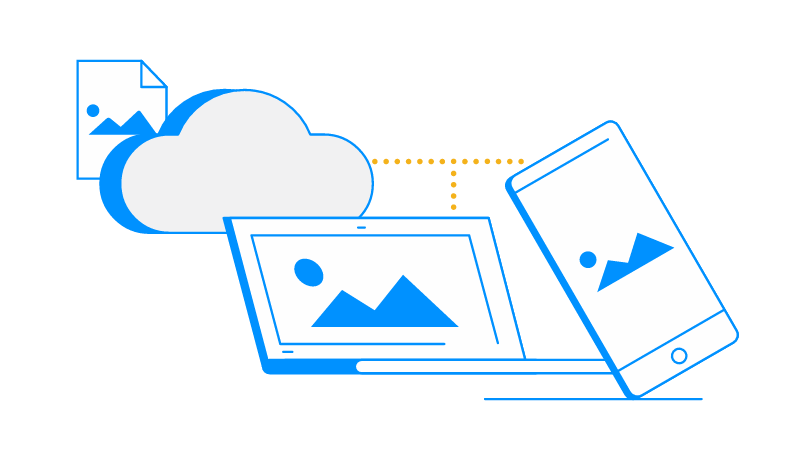Upleveling your digital asset management strategy for the modern workforce
The visual elements created and utilized across your organization deserve a DAM solution as innovative as you are.

Visual content offers a powerful way to connect with and engage consumers. It also helps companies maintain a competitive advantage where such an edge matters. But when it comes to creating, managing, and publishing the volumes of content required to win the engagement game today, it can be a challenge just to keep up. Those in charge of assets must think through every possible variation ahead of time and create a huge number of variants of each asset, for every channel and screen size on which it might be displayed.
In most organizations, it’s also hard to make sure every team has access to these assets when they need them, and that they know how to optimize them for each channel they use them on. Now that the COVID-19 pandemic has led to widespread remote work and distributed teams – not to mention more fluid work schedules – it is even more challenging to establish and maintain efficient and productive workflows.
Expecting creatives and developers to address these needs and challenges alone zaps resources and misallocates the skillsets of your most talented people. Your teams should be brainstorming new content ideas, dreaming up unique visual experiences, and strategizing on campaign elements – not worrying about file sizes and cropping ratios. Fortunately, it doesn’t have to be this way.
A well-designed DAM (Digital Asset Management) solution handles this at-scale content demand with ease. Advanced DAMs have moved beyond once-rudimentary databases for ingesting, storing, and accessing assets. Today, they automatically manage huge chunks of the optimization and delivery process for you. They generate variants through intelligent cropping and resizing, and make it incredibly simple to produce new assets from existing ones. Holistically, modern DAMs improve workflows across the enterprise. Here’s how.
AI-driven organization and analytics are a powerful combination for campaign planning
Three core capabilities of dynamic DAMs include the ability to automatically transform and optimize assets, preview the variations easily, and finally, publish the assets in an optimal format. Before this can happen, though, organizations need to get their arms around the assets already in their arsenal, which requires informed planning assisted by AI.
For brands with massive libraries of imagery and videos, AI automatically identifies content to facilitate the rapid deployment of metadata, adding the appropriate tags or search terms to make content instantly searchable. This is especially useful for media libraries that serve retail, tourism and hospitality. For example, the value of AI can really be appreciated when you think of the number of apparel pieces – and how many product photos each of them require – retailers need to prepare and display each fashion season.

In most scenarios, it’s best to not reinvent the content wheel if you don’t have to. In many cases, teams will request a new custom image when an existing asset already works for the experience they want to deliver, they just don’t know it’s available. In a modern DAM with AI-fueled tagging and analytics, content-creating teams can know with certainty what they already have. If an asset is rarely used, the analytics can speak to why that is, enabling teams to enhance the asset or create a different version. User-engagement metrics help content creators gain valuable insights in order to repurpose or optimize existing content.
Critical image and video transformation is expedited with AI
In addition to keeping the whole organization organized and helping them source the assets they need, AI shoulders the burden of editing and optimization. It can automatically pinpoint the primary foreground subjects in a photo, manipulating the background to eliminate distracting content. Because the asset will be displayed on various devices and screen sizes, AI auto-crops images each required aspect ratio. Everything takes place within the DAM, so there is no need to download assets, edit in external tools, and reupload new versions.

As much as content is king, video in many ways reigns supreme. Back to the retail example: a photo of a handbag quickly registers in a consumers’ mind when they first see it, helping them to notice close-up details of the material or stitching, or how many interior pockets the bag has. But a 10-second video clip on that product page, showing a woman packing the purse with ease, and suddenly the true form and function of the handbag resonates with the shopper.
That’s why dynamic video transformation is key when selecting a DAM. By leveraging AI, dynamic DAMs create short previews of a video, focusing only on the most important and compelling section. Videos can be streamed on the DAM during their encoding phase. Uploaded videos can be automatically transcoded and optimized for any web browser and mobile device, and videos, just like images, can be resized and cropped intelligently.
How to deploy a DAM, considering emerging technology and distributed workforces
With sights set on implementing a truly modern DAM, it’s important to know the boxes to check when evaluating options. Having a single, cloud-based platform is a top priority, which has been made more obvious in the times of COVID-19 with more physically distributed teams and remote collaboration. A SaaS-based DAM solution breaks down logistical barriers to accessing the platform, wherever a team member might be working from, so that work can continue without interruption. Think of a DAM as the productivity bridge, closing the functional gap between asset management and content delivery.

What other advanced capabilities are needed for creating modern asset workflows, supported by DAMs? Over the past several years, workflows have certainly evolved. Simply ingesting assets, storing them in some organized fashion, and allowing for access and searchability are bare-bones DAM requirements at this point. Today, look for a DAM that is by nature:
- Mobile-first, automatically adapting assets to display attractively on any device or screen size – including mobile – which requires intelligent cropping, resizing, and adjustments made on the fly.
- Supportive of rich media, able to transform next-generation image formats, videos, 3D models, animated GIFs, and 360-degree images. Tools in these cutting-edge DAMs automatically transcode, crop, and resize all rich media to create multiple versions for different uses.
- Equipped for last-mile asset delivery, delivering creative assets to end-users at high quality and quick load times. DAMs generate URLs for assets, which can be used directly in websites and mobile apps to ultimately deliver content through a fast Content Delivery Network (CDN).
Setting up DAM as a critical core platform with tech-stack integration
Importantly, the boundaries of DAM are extensible, and the organization-wide possibilities aren’t limited by the list of platform features. That’s because DAM capabilities are extended through integrations with many other valuable enterprise systems your teams rely on daily. Just make sure that your DAM system has built-in connectors for all the systems that work with creative assets: CMS, eCommerce platforms, Product Information Management (PIM) systems, CRM systems, BPM and ERP tools, social media, and marketing tools. Ensuring this on the front end, prior to sealing the deal, will help to future-proof your team’s content expertise and the resulting gains in efficiency.
To make these integrations a reality, the DAM should include a host of APIs, SDKs, and Widgets that make other systems easy to integrate. If there’s cohesion across your tech stack, you can quickly eliminate barriers to asset delivery. Especially important? You’ll ensure a single source of truth for every asset across every team and asset delivery. This single source of truth goes a long way in maintaining brand standards, enforcing usage or copyright compliance, and tracking version history.

Prioritizing company culture and buy-in as you implement
A DAM solution will bring new levels of efficiency to an organization and solve for many issues teams constantly facet. However, if you don’t involve your people in the planning for and implementation of your DAM, you may be fighting a battle of the wills so that the DAM can play the best supporting role possible.
One way to ensure a DAM platform boosts the work already being done well is to identify the critical business workflows that relate to content – this goes beyond just the marketing team or graphic designers, to gain perspective from developers and IT stakeholders whose voices matter in the conversation. Interview team members who frequently perform those tasks so that you can better understand their needs, and then, together, identify clear opportunities for automation. When these opportunities are agreed upon, ready adoption of new asset workflows improves. Automated workflows will improve productivity and increase the usage of visual assets, but it’s also reliant on teams communicating to ensure the wheels keep turning.

DAM is a truly foundational platform for executing campaigns across every business group in a modern economy and a critical part of the martech stack for organizations today and moving forward.
Digital asset management platforms: A snapshot
What is it? Anyone who’s struggled to find a file on their computer or shared drive understands the pain of tracking down content. And when you consider the sheer amount of files you need to sort through when many versions are created to resonate with specific audiences, these tasks can feel overwhelming. Digital asset management platforms simplify these tasks by bringing all of your marketing content together.
Why are they important? Marketers are creating engaging content for more channels than ever before, which means the software used to manage these assets is gaining importance. What’s more, the communications between businesses and their customers are increasingly digital. Marketing content today is created in a wide variety of formats and distributed wherever consumers are digitally connected.
Why we care. When those creating and using content aren’t near one another, having a central repository for assets is helpful. Finding the right content for your audience is made simpler when each version is organized in the same location. For these reasons and more, your marketing operations could benefit from adopting a digital asset management system.
Related stories
